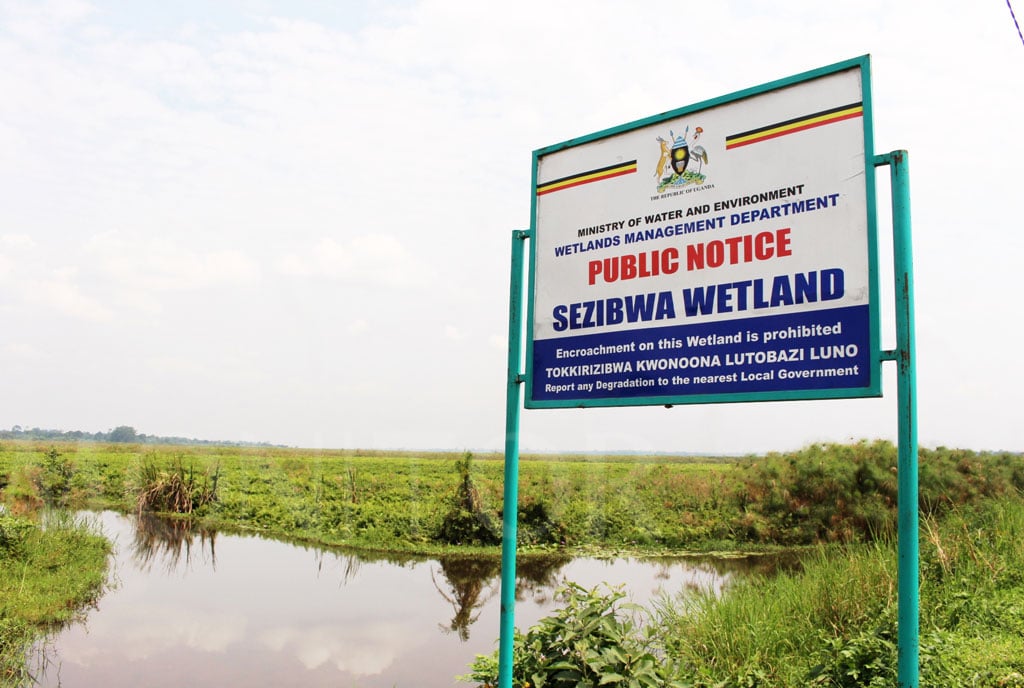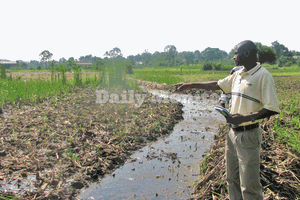
A section of river Ssezibwa along the Kayunga-Mukono highway where water levels have reduced.
Standing in front of the waterfalls at River Ssezibwa in Nakisunga sub-county, Mukono district, three foreign tourists take a series of photograph.
Located in the middle of a still-intact natural forest, the roaring sound of the waterfalls, the singing birds, the beautiful view of sharp-edged rocks, and a cool environment, create a beautiful scenery in the remote Kkungu-Madudu village, located about two kilometers off Kampala-Jinja highway, near Kayanja trading centre. The waterfalls are among the few tourism sites in the district, hosting at least ten tourists a day.
The site belongs to Buganda kingdom. However, the beautiful waterfalls and the surrounding natural forest are threatened with extinction because of river's shrinking water levels. Eng. Maximo Twinomuhangi, the team leader, Kyoga Management Zone in the Ministry of Water and Environment, under which Ssezibwa Catchment falls, attributes the reducing water levels in the river to climate change.
“Climate change has affected the availability of rainfall received in the catchment area and this could be the leading cause of the reduction in water levels in the river. Either the rainfall has not been enough, or it has been coming in large amounts in a short period of time,” he says.
Eng. Twinomuhangi decries the poor land methods by the people living in the Ssezibwa catchment area, which have also negatively impacted the river's water levels. "People cultivate rice in Ssezibwa wetland and they have dug water channels to divert water to their gardens. This interferes with the normal flow of the river. When the river finally dries up, the potential for conflict becomes high among those who depend on it for their livelihoods," he adds.
With its source in Kawuna village, Ngogwe sub-county in Buikwe district, River Ssezibwa is 150 kilometers long, passing through the districts of Buikwe, Mukono and Kayunga, and eventually pouring into Lake Kyoga.
An estimated one million people derive their livelihood from the river and the surrounding wetland, through fishing, water for irrigation and domestic use, harvesting papyrus for making crafts, harvesting of herbal medicine from rare trees and bush meat.

Boat making is one of the income generating activities for people around River Ssezibwa in Kayunga District. PHOTO/FRED MUZAALE
Francis Muwambi, a tour guide at Ssezibwa Falls, says during the long dry season, the intensity of the waterfalls decreases and only regains its flow during rainy periods. "We began seeing a reduction in water levels about nine years ago, and now we fear that that in the future we will not have waterfalls. Something must be done immediately to restore the river to its original form because both Mukono district and the central government collect taxes from this tourism site. We employ over 30 workers,” Muwambi says. Restoration effortsJazira Nakiri, the senior environment officer for Buikwe district, says some sections of the river, which were once wide, have turned into small streams due to encroachment. "During the dry seasons, the wetland discharges water into the river and during rainy seasons, they reserve it. People are illegally growing rice in the wetland in Kawuna village and diverting the course of the river.
The reduction of water levels has also caused fish stock to dwindle,” she says. According to the 2021 Wetlands Status Report in Mukono district, a study carried out by the Ministry of Water and Environment, out of 8,372 hectares of wetlands in the district, 64.8 percent are degraded while 35.2 percent remain intact.
In Buikwe district, 56 percent of the wetlands are degraded. “Buikwe district has developed a district climate action plan and as intervention to address climate concerns. This plan includes adaptation and mitigation actions. We have also engaged the ministry to restore the degraded section of Ssezibwa wetland,” Nakiri says.Engagement meetings She adds that the ministry has done spot mapping of the river and engagement meetings with stakeholders will soon commence.
“We will soon start demarcating the river’s boundaries and have pillars erected. The district has issued 290 administrative stop notices to encroachers, who cultivate rice, sugarcane and eucalyptus, to vacate the wetlands,” Nakiri says.
She is optimistic that with the climate action plan in place, the river’s degraded state will be redeemed.

A signpost erected by the ministry of water and environment warning people against encroaching on the Ssezibwa wetland. PHOTO/FRED MUZAALE
Deogratius Ssaazi, the Ssezibwa wetland system supervisor, reveals that the most degraded sections of the river and wetland are located in urban areas like Mukono Municipality.
“There is a high demand for land to build industries and homes, brick and sand in such areas, but we cannot evict wetland encroachers before we sensitising them about leaving a buffer zone between themselves and the river and wetland,” he says. In some areas like Nazigo and Kayunga sub-counties, farmers descend on the wetland during the dry season to grab land to grow crops. Some of them have sold off parts of the land.
However, attempts to evict them have fallen on deaf ears because the district does not have an enforcement arm. “In Kayunga sub-county and Kayunga Town Council, the trees that grow in the wetland have been cut down for charcoal burning. If the locals feel that their livelihoods are being lost because of the receding river, they should embrace the poverty alleviation programs offered by the government,” Patrick Musaazi, the Kayunga district senior environment officer, says. Charles Kakonge, a resident of Bukolooto town in Kayunga district, confirms the dwindling fish stocks of the river.
“The river has fish species like lung fish, cat fish and tilapia. It also has wild animals like antelopes, waterbucks and rare birds, but they are fast disappearing. I used to sell fish at Ntooke Landing Site earning Shs50,000 per day, but now, there are days I fail to catch even one fish. Sometimes, on a good day, I make Shs15,000,” he says. Kakonge has now resorted to mending fishing boats to make ends meet. Rita Nabalamba, who has for the last five years been making crafts from papyrus, now has to walk deeper into the wetland to harvest the plants. “Most parts of the wetland, such as Kantenga, where we used to get the papyrus are now degraded. Our profit margin has reduced because we must walk long distances to cut the papyrus and then, spend a lot of money to transport it to our workstations,” she says.

A fisherman holds fish from River Ssezibwa in Kayunga District. PHOTO/FRED MUZAALE
Eng. Twinomuhangi says the ministry is implementing the Ssezibwa Catchment management plan, under the Kyoga Management Zone, which is a holistic approach that tries to understand issues like poverty, in the catchment area, and how to address them. "We are working with seven districts to promote tree-planting and minimise encroachment. However, there is need for the government to rethink strategic measures to harvest and store water during rainy seasons for use during long dry periods,” he says.
Robert Mulondo, the chief administrative officer of Buikwe district, notes that the district and Makerere University are charting a way forward on how to save River Ssezibwa and the catchment area. “We are implementing a project whose main objective is finding ways to restore the wetland. Under the project, we are documenting the level of degradation and how the river’s tributaries like Mubeya wetland can be protected,” he says.
Many tourism sites are facing challenges of encroachment and River Ssezibwa is no exception. With these efforts being made to save the river, wetlands, and waterfalls, Ugandans should jealously protect the natural resource in their areas not only for sustainable tourism but also conservation of the environment.
About River Ssezibwa
River Ssezibwa is located 32kms from Kampala City, along the main road from Kampala to Jinja in the district of Mukono.
The Ssezibwa falls are a result of water squeezing through narrow opening of rocks and dropping at great speed (17 meters) into a large pool that is about 14 meters deep.
The area around the falls is one of best places to go for relaxation after a long wildlife safari in Uganda or before visiting the source of the Nile River for activities like Whitewater rafting or bungee jumping. The name Ssezibwa is a local idiom referring to “something endless”.
The Sezibwa falls are also considered an important cultural and spiritual site for the Baganda people. They also are one of the top things to see in Uganda. The site is under the administration of the Buganda culture and tourism department,




